TOP > News Release > Otsuka Pharmaceutical Factory surveys the actual condition of dietary and nutritional care at home-visit nursing offices. Only about 8.2% determine undernutrition using objective "evaluation indicators (nutrition assessment tools)."
June 17, 2022
Otsuka Pharmaceutical Factory, Inc. (Head Office: Naruto, Tokushima, Japan; President and Representative Director: Shinichi Ogasawara; "OPF"), under the supervision of healthcare professionals involved in the dietary and nutritional care of home care patients, conducted a "survey on the status of implementation of dietary and nutritional care for elderly people receiving home health care" targeting home-visit nursing offices, which are regular members of the National Association for Visiting Nurse Service.
As a result, about 90% of the nursing offices mentioned "changes in body weight," "physical symptoms," and "dietary intake" as determining criteria to set "undernutrition" as a nursing issue for people receiving home health care. On the other hand, it was found that the rate of body weight measurements, which places a heavy burden on the nursing care field, varies greatly from place to place, and there may be a lack of criteria for setting "undernutrition." In addition, only about 8.2% of the offices used objective "evaluation indicators (nutrition assessment tools)" as determining criteria, suggesting that there are variations in evaluation methods for undernutrition.
In addition, while many offices cited "request of the person themselves and family" and "difficulty with oral intake" as reasons for not intervening in users with undernutrition (excluding those in terminal phase), 16.6% cited "not knowing effective intervention methods" and 12.1% cited "lack of specialists in partners they collaborate with." These results indicate that there are a certain number of offices that have not found concrete solutions due to lack of collaboration, etc., although they are aware of the importance of nutrition issues. Furthermore, many offices cited "fax," "telephone," and "mail" as the media used for collaboration on food and nutrition information, and 16.6% cited "ICT sharing tools." This indicates that the use of ICT tools that enable people concerned to share and visualize issues has not yet become widespread.
According to a nutrition assessment survey*1 conducted by MNA-SF (Mini Nutritional Assessment Short Form) for 993 home care patients aged 65 years or older, about 36% of the patients were "undernourished" and about 34% were "at risk of being undernourished." In total, about 70% of the patients have been reported to have some kind of nutritional problems. In addition, it has been pointed out that many elderly people receiving home health care are urgently hospitalized due to the causes of pneumonia and fractures,*2 and that the three common backgrounds of "undernutrition," "sarcopenia,*3" and "frailty*4" are directly and indirectly involved.*5 Therefore, solving nutritional issues is important as an approach to prevent emergency hospitalization.
Based on the management vision of "The Best Partner in Clinical Nutrition," OPF aims to be the best partner in the field of clinical nutrition by continuously providing information and products that are useful for proper nutritional management.
Based on the corporate philosophy of "Otsuka-people creating new products for better health worldwide," the Otsuka Group is dedicated to contributing to the health of people around the world.
*1 FY 2012 Health Promotion Project for the Elderly: Research Report on Eating and Nutrition of Home-care Patients
http://www.ncgg.go.jp/ncgg-kenkyu/documents/roken/rojinhokoku4_24.pdf (as of June 2022)
*2 Sasaki J, et al. Medical Alliance. 2015;Vol. 1 No.1:71-77.
*3 A condition of age-related loss of skeletal muscle mass
*4 A condition in which resilience to stress is reduced due to a decrease in reserve capacity with aging
*5 Yoshida S. Jomyaku Keicho Eiyo (Journal of Japanese Society for Parenteral and Enteral Nutrition). 2013;Vol. 28 No.5:1051-1056.
Survey Name: Questionnaire on the Implementation of Dietary and Nutritional Care in Elderly People Receiving Home Care
Survey Period: February 7 to February 28, 2022
Survey Target: 379 offices that responded among the regular members of the National Association for Visiting Nursing Service
Survey Method: Internet Survey
Please tell us determining criteria for setting "undernutrition" as a nursing issue (as stated in the plan, etc.)
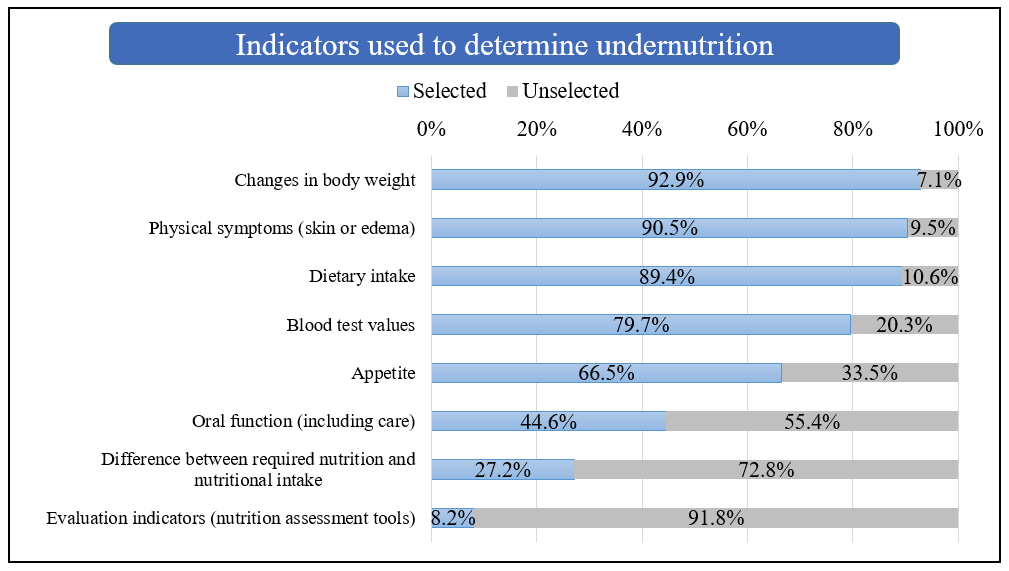
Please tell us why you do not (cannot) intervene in users with undernutrition (excluding those in terminal phase).
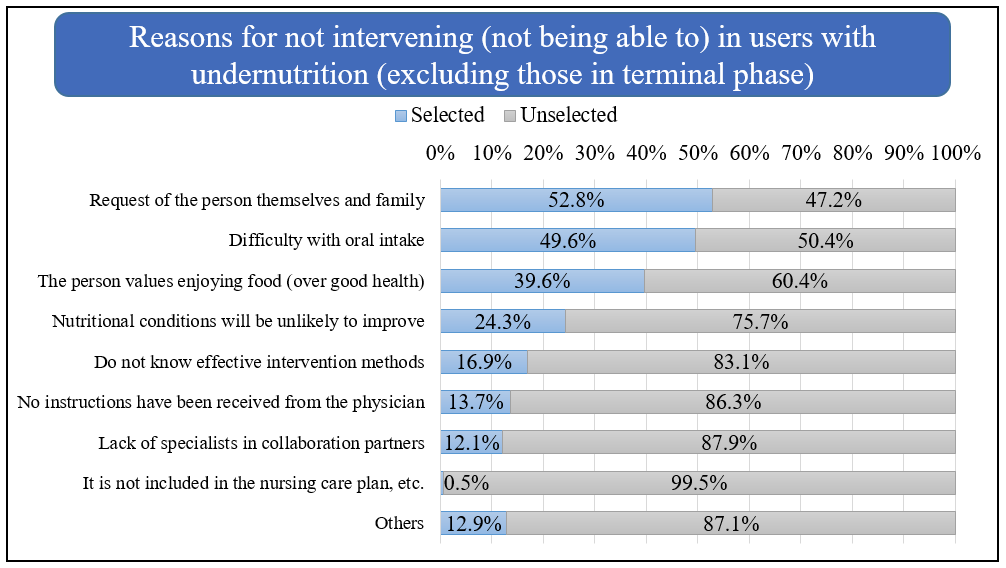
Please tell us the media used for collaboration and cooperation on "dietary and nutritional information."
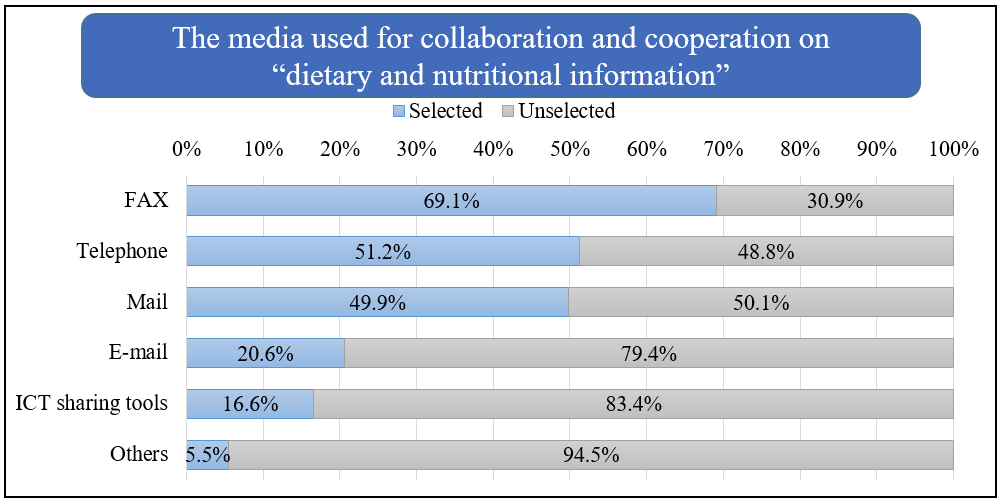
How many users of your offices are monitored for their body weight (including measurements at home, other services, etc.)?
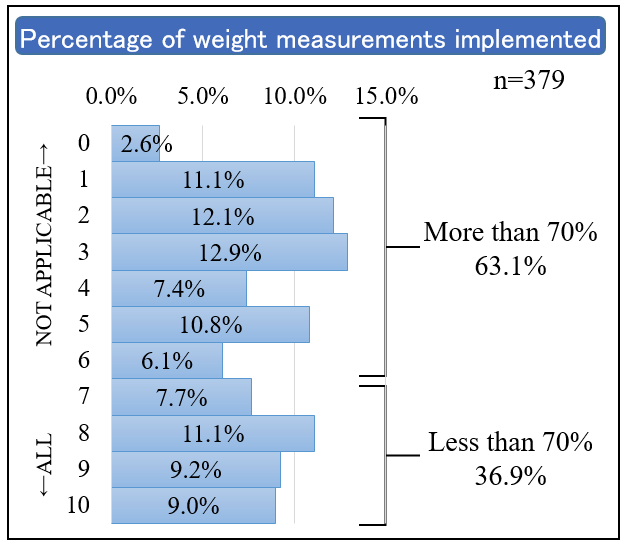
<Reference> Here are some excerpts of the other main results.
Please tell us the percentage of people who are "undernourished" among the total number of users at your office.
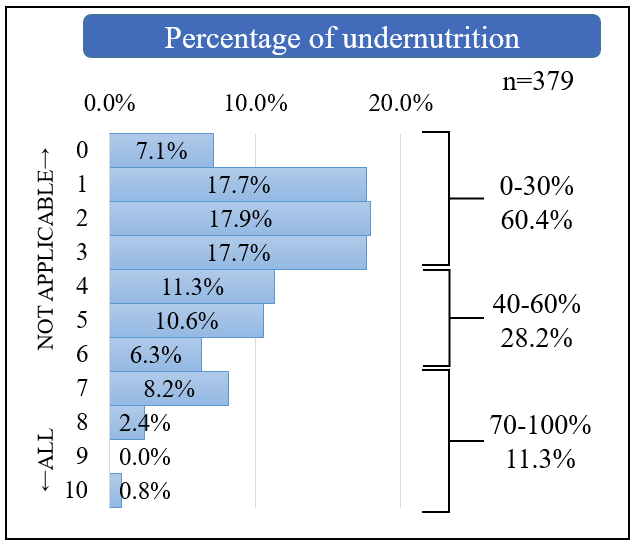
Cross-tabulation of "percentage of weight measurement implementation" and "percentage of undernutrition"
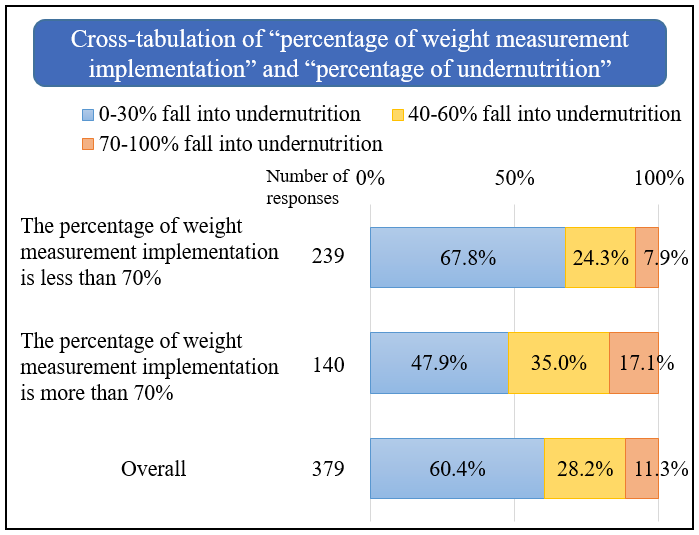
For details of the survey results, please refer to the following:
URL: https://www.otsukakj.jp/news_release/20220617_1.pdf (Japanese only)
Hiroko Utsunomiya (Representative of Utsunomiya Hiroko Office, Home Care Transition Support Institute)
Visiting nurses notice a variety of problems because they observe the general condition of the patients, but I think that it is difficult to list them as nursing issues unless solutions are found. Some of them may be unfamiliar with dietary and nutritional care. I think it would be easier for visiting nurses to understand dietary and nutritional care if there was a way to check the points to pay attention to and the response to the solution as a process, including successful cases. Collaboration with day-care centers for the elderly makes it easier to check meal scenes, and it is also important to communicate the information obtained to care managers.
Mikiko Kawaguchi (Professor, Faculty of Home Economics, Otsuma Women's University)
In this questionnaire we found that there were problems such as "low awareness of nutrition," "no awareness of nutritional issues," and "I was able to raise issues, but I do not know specific care." As doctors and nurses practice the concept of Problem Oriented System (POS), registered dieticians have studied the nutritional care processes and can make nutritional diagnoses. From the understanding of nutritional intake, digestive and absorptive capacity, basic diseases, behavior, and environment, they can see and think about why certain patients cannot eat. I would like to tell them that registered dietitians can respond to the problems of nurses.
Dr. Jun Sasaki (Chairman of the Yushoukai Medical Corporation and Director of the Medical Department)
At home care, there is an issue that undernutrition is not cited as a problem. The results of this survey suggest that nursing offices that have skills in using certain preliminary knowledge and tools for undernutrition have a high probability of being able to extract undernourished patients. Visiting nurses carefully plan their nursing care, thus I think it is important to see changes in body weight and other factors as a matter of course.
Hiroko Takasuna (Manager, Home-Visit Nursing Care Center, Minami-ku Medical Association)
Recently, we have experienced situations where nursing care imposes such a heavy burden on home-visit nurses because there is nobody to support people receiving home care that they cannot go further to handle nutritional care. The facts behind this are as follows: people who are receiving home care are living alone; caregivers themselves have dementia; and the elderly take care of another elderly person. Visiting nurses support home care patients after discharge by continuously carrying out care provided during the hospitalization. I think the contents of care can be read from the results of the questionnaire. Although cooperation of dieticians is important for home health care too, the number of dieticians who are active in home health care is still small. Therefore, I hope that the number will increase and that the cooperation will be realized in the future.